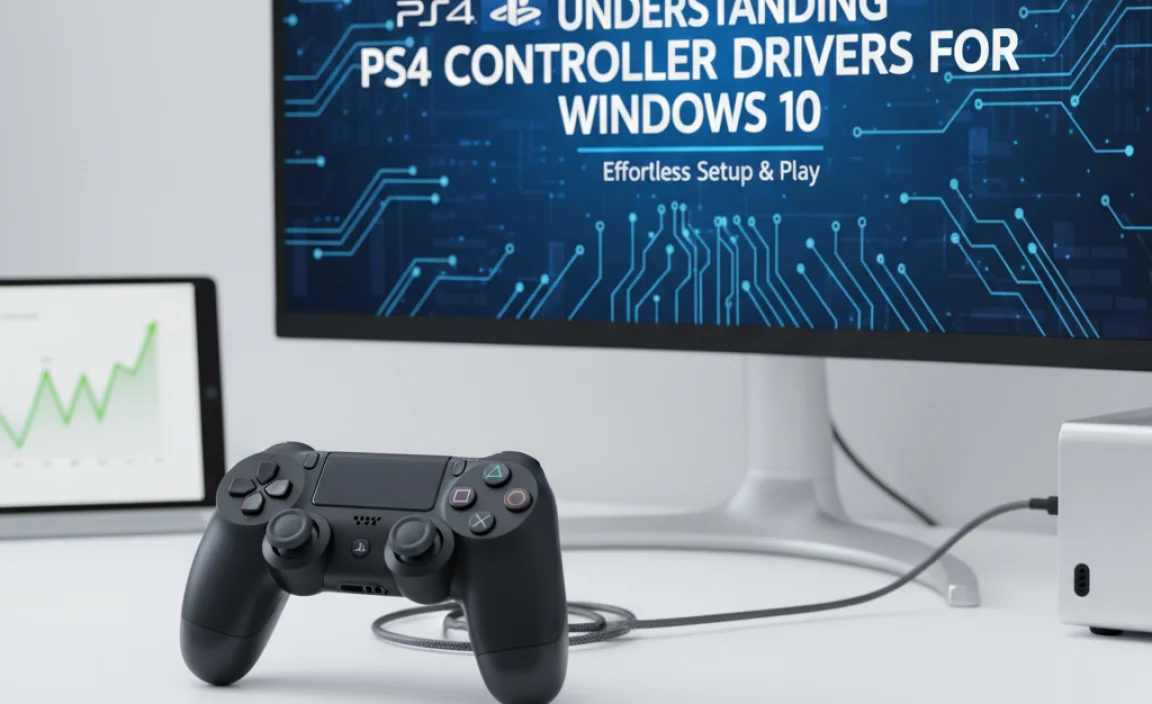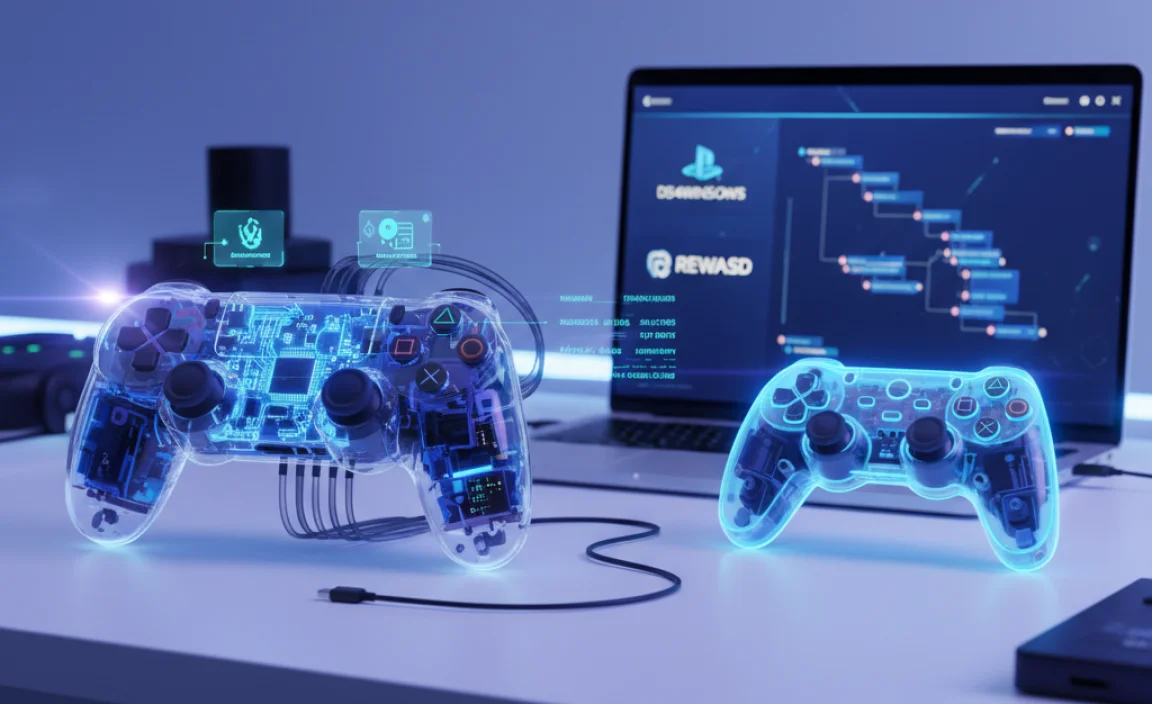Integrating your PlayStation 4 controller with Windows 10 for gaming sessions shouldn’t feel like a Herculean task. With the right knowledge, this process can be remarkably effortless, unlocking a more immersive and familiar gaming experience on your PC.
Gone are the days of wrestling with obscure settings or proprietary software; for most users, getting your DualShock 4 recognized and functional on Windows 10 is a straightforward plug-and-play affair, with a few optional steps for advanced users.
Whether you’re looking to enjoy PC ports of games that feel designed for a controller, or you simply prefer the ergonomics of the DualShock 4 over keyboard and mouse, understanding how to set up its drivers is key. This guide will walk you through the process, from the most basic setup to more advanced configurations, ensuring you can get back to your games with minimal fuss.
Understanding PS4 Controller Drivers for Windows 10

The good news is that Windows 10, in its continuous efforts to be a more versatile gaming platform, has excellent native support for the PlayStation 4 controller. This means that in most cases, you won’t need to download any special, third-party drivers to get the basic functionality working.
When you connect your PS4 controller to your Windows 10 PC via a USB cable, the operating system should automatically detect it and install the necessary drivers. This typically involves recognizing the controller as a generic gamepad.
However, this native support might not always unlock the full potential of your DualShock 4. Features like the touchpad, motion controls (gyroscope/accelerometer), and the light bar might not work as intended or at all without a little extra configuration. This is where understanding how to manage and potentially enhance these “drivers” comes into play.
The Wired Connection: The Simplest Path
For the quickest and most effortless setup, a wired connection is your best friend.
1. Connect the Controller: Grab a compatible Micro-USB cable (the same one you use to charge your PS4 controller) and plug one end into the controller and the other into a free USB port on your Windows 10 PC.
2. Windows Detection: Windows 10 should automatically recognize the controller. You might see a notification indicating that new hardware is being installed. Once this process is complete, your controller should be ready to use in most games that support gamepads.
This direct connection bypasses any potential wireless interference and is generally the most stable way to use your controller.
The Wireless Connection: Bluetooth Convenience
If you prefer the freedom of a wireless setup, your PS4 controller can connect to your Windows 10 PC via Bluetooth. This requires your PC to have a built-in Bluetooth adapter or a separate Bluetooth dongle.
1. Enable Bluetooth on PC: Go to `Settings` > `Devices` > `Bluetooth & other devices` and ensure Bluetooth is turned on.
2. Pair the Controller:
With the controller off, press and hold the `PS` button and the `Share` button simultaneously for a few seconds. The light bar on the controller will begin to flash rapidly, indicating it’s in pairing mode.
On your Windows 10 PC, click `Add Bluetooth or other device` > `Bluetooth`.
Your PC will scan for nearby Bluetooth devices. Select `Wireless Controller` when it appears in the list.
Follow any on-screen prompts to complete the pairing process.
Once paired, your controller will connect wirelessly whenever it’s turned on and within Bluetooth range of your PC.
Advanced Features and Third-Party Tools for PS4 Controller Drivers for Windows 10

While native support covers the basics, you might want to utilize advanced features like the touchpad as a mouse, map buttons, or enable rumble. For these functionalities, especially for games that don’t natively support the DualShock 4’s unique features, third-party software is often the solution.
DS4Windows: The Go-To Solution
Arguably the most popular and robust tool for maximizing your PS4 controller’s potential on Windows 10 is DS4Windows. This open-source application allows you to emulate an Xbox 360 controller, which has broader native support across PC games than the DualShock 4.
Key features of DS4Windows include:
Xbox 360 Controller Emulation: Makes your PS4 controller appear as an Xbox 360 controller to games, ensuring compatibility.
Button Mapping: Remap any button to another function, including keyboard keys, mouse actions, or other gamepad buttons.
Touchpad Functionality: Configure the touchpad to act as a mouse, a D-pad, or even for specific in-game actions.
Light Bar Customization: Change the color of the light bar, adjust its brightness, or have it react to in-game events.
Motion Controls: Enable and configure the controller’s gyroscope and accelerometer for games that support motion input.
Macro Creation: Set up complex command sequences to be triggered by a single button press.
Profile Management: Create and save different profiles for various games, allowing for quick switching between customized settings.
Setting up DS4Windows:
1. Download DS4Windows: Search for “DS4Windows GitHub” online and download the latest release from its official repository.
2. Extract the Files: DS4Windows is a portable application, meaning you don’t need to install it. Simply extract the contents of the downloaded ZIP file to a folder on your computer.
3. Run DS4Windows: Launch the `DS4Windows.exe` file.
4. Install ViGEmBus Driver: The first time you run DS4Windows, it will prompt you to install necessary drivers, including the ViGEmBus driver (which is crucial for emulating an Xbox 360 controller). Follow the on-screen instructions to install these.
5. Connect Your Controller: Connect your PS4 controller to your PC, either via USB or Bluetooth.
6. Configure Settings: DS4Windows will detect your connected controller. You can then browse through the tabs to customize button mappings, touchpad settings, light bar colors, and more. Create profiles for your favorite games to optimize your experience.
Steam Integration
For users who primarily game through Steam, the platform offers excellent built-in support for the PS4 controller.
1. Launch Steam: Open your Steam client.
2. Enable PS4 Configuration Support: Go to `Steam` > `Settings` > `Controller` > `General Controller Settings`.
3. Activate PS4 Configuration Support: Check the box that says “PlayStation Configuration Support.”
4. Connect Your Controller: Connect your PS4 controller. Steam should detect it.
5. Game Adjustments: Within Steam’s Big Picture Mode or by right-clicking a game in your library and selecting `Properties` > `Controller`, you can finely tune your PS4 controller’s input for each game. Steam’s tools allow for extensive customization, including remapping buttons, configuring the touchpad, and even setting up motion controls.
Troubleshooting Common Issues
While the process is generally smooth, you might encounter a few hiccups.
Controller Not Detected: Ensure your USB cable is working correctly and try a different USB port. For Bluetooth, make sure Bluetooth is enabled on your PC and that the controller is in pairing mode. Restarting your PC can also resolve temporary glitches.
Input Lag (Wireless): Bluetooth can sometimes introduce minor input lag. For competitive gaming, a wired connection is always recommended. Ensure your Bluetooth drivers are up-to-date.
Button Prompts in Games: Some games might display Xbox button prompts even if you’re using a PS4 controller. This is usually a cosmetic issue and doesn’t affect gameplay. DS4Windows can often help by making the game recognize it as an Xbox controller.
* Driver Conflicts: If you’ve previously used other controller emulation software, it might cause conflicts. Uninstalling older software and drivers before installing DS4Windows can help.
In conclusion, getting your PS4 controller to work on Windows 10 is not a challenging endeavor. With native Windows support taking care of the basics, and powerful tools like DS4Windows and Steam’s own configuration options, you can achieve an effortless and highly customized gaming experience. So, plug it in, connect via Bluetooth, or dive into the advanced settings – your favorite games await!
